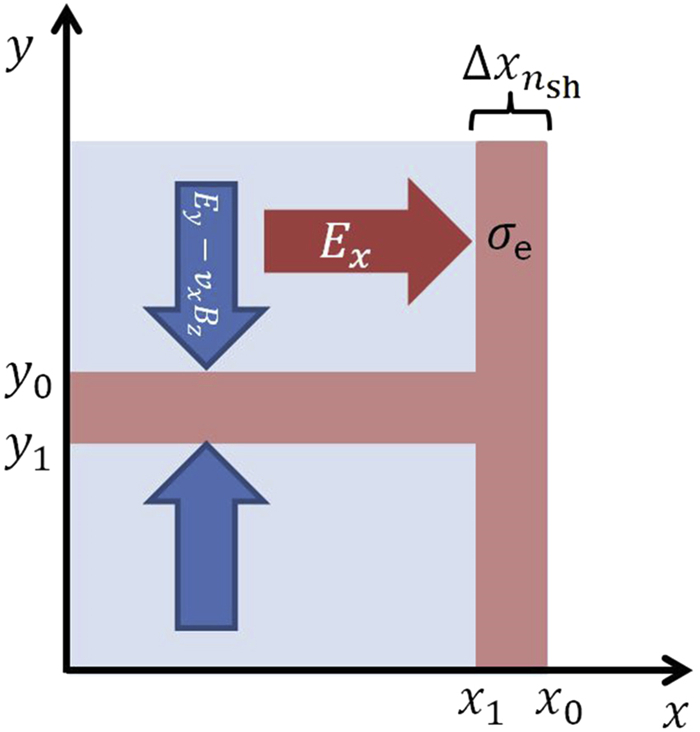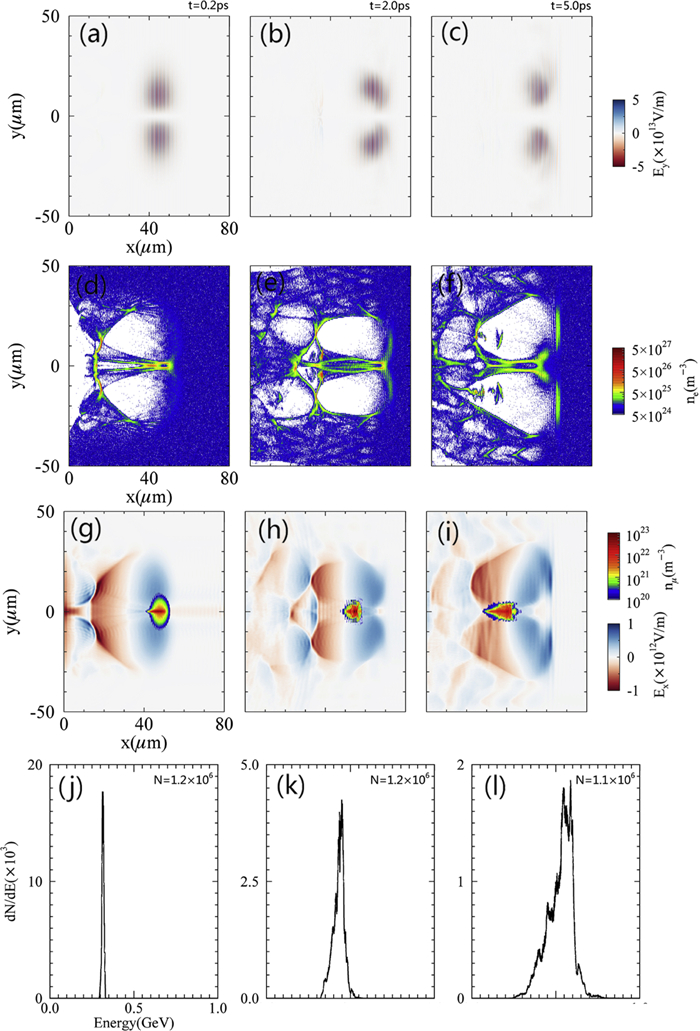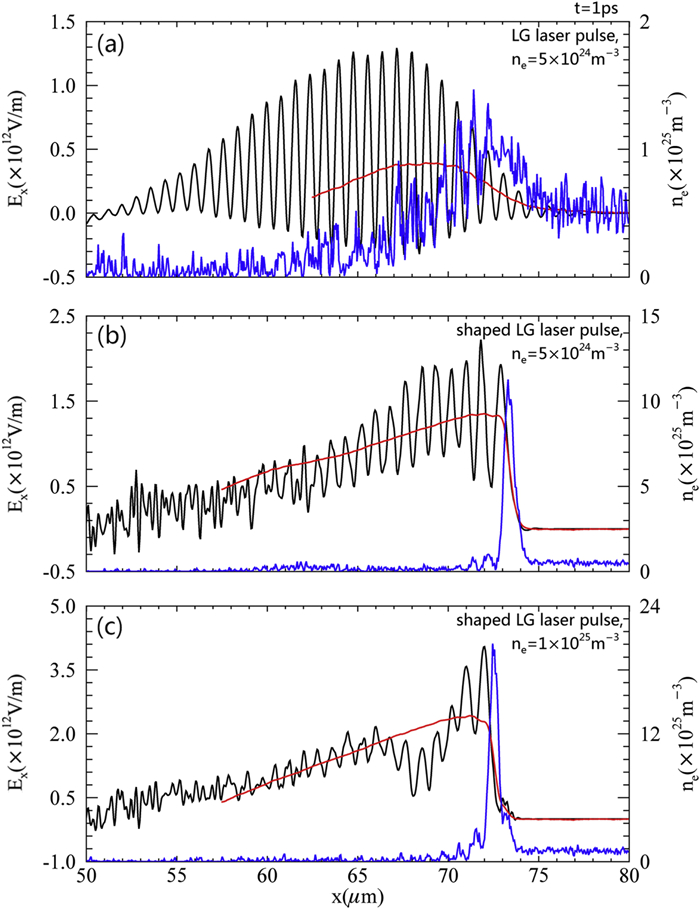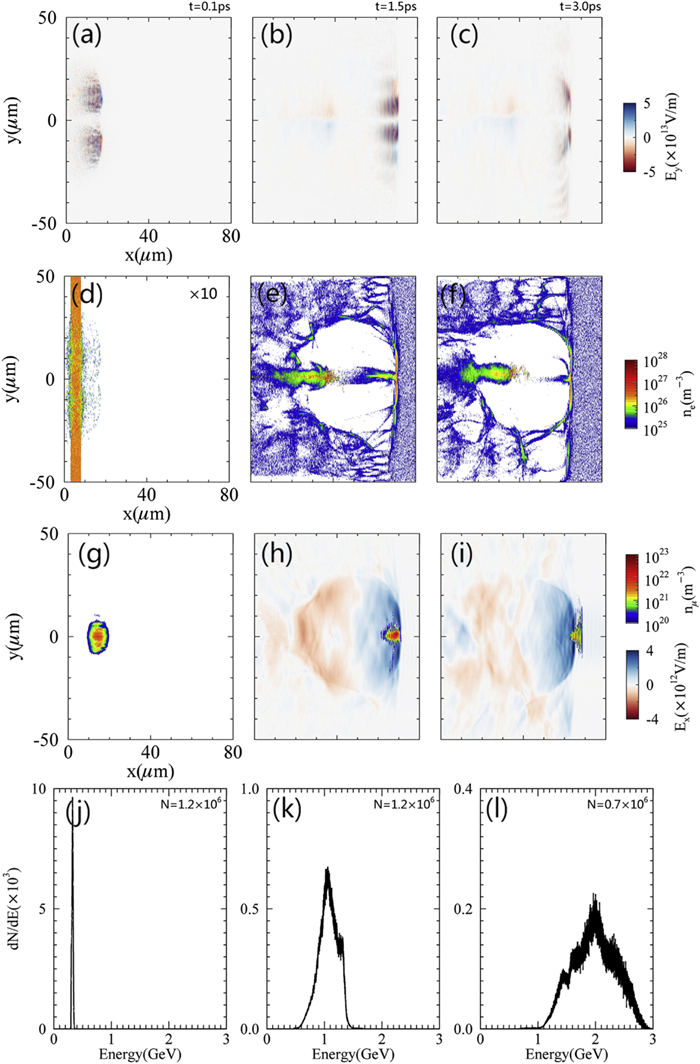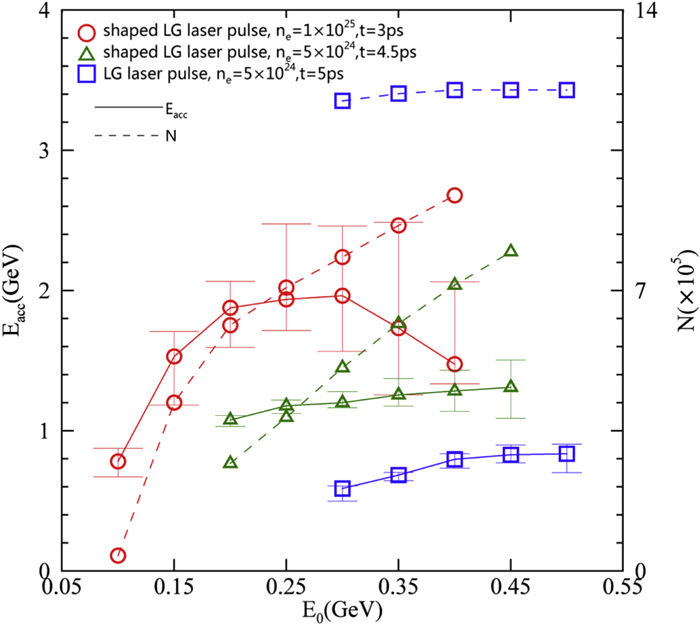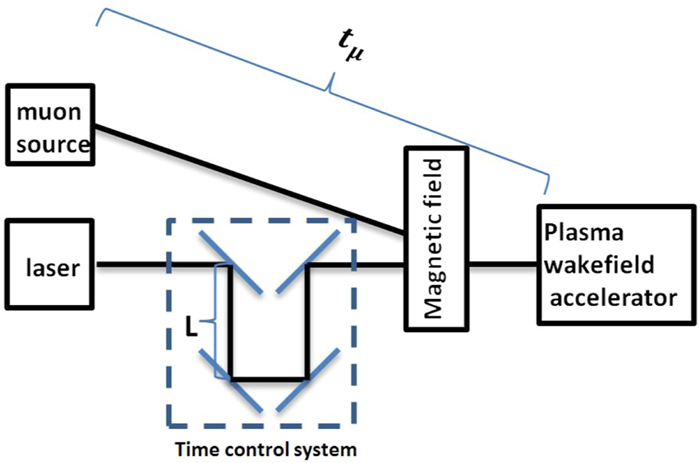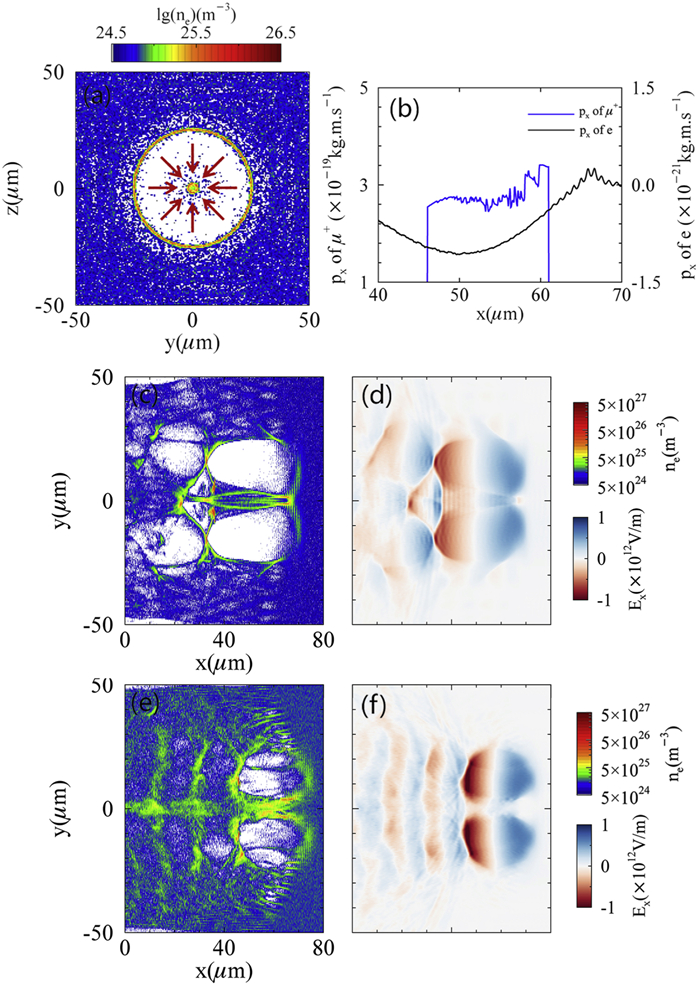
| Citation: | Xiaonan Wang, Xiaofei LAN, Yongsheng HUANG, Youge JIANG, Chunlei ZHANG, Hao ZHANG, Tongpu YU. Prompt acceleration of a μ+ beam in a toroidal wakefield driven by a shaped steep-rising-front Laguerre–Gaussian laser pulse[J]. Plasma Science and Technology, 2022, 24(5): 055502. DOI: 10.1088/2058-6272/ac58eb |
Recent experimental data for anomalous magnetic moments strongly indicates the existence of new physics beyond the Standard Model. Energetic μ+ bunches are relevant to μ+ rare decay, spin rotation, resonance and relaxation (μSR) technology, future muon colliders, and neutrino factories. In this paper, we propose prompt μ+ acceleration in a nonlinear toroidal wakefield driven by a shaped steep-rising-front Laguerre–Gaussian (LG) laser pulse. An analytical model is described, which shows that a μ+ beam can be focused by an electron cylinder at the centerline of a toroidal bubble and accelerated by the front part of the longitudinal wakefield. A shaped LG laser with a short rise time can push plasma electrons, generating a higher-density electron sheath at the front of the bubble, which can enhance the acceleration field. The acceleration field driven by the shaped steep-rising-front LG laser pulse is about four times greater than that driven by a normal LG laser pulse. Our simulation results show that a 300 MeV μ+ bunch can be accelerated to 2 GeV and its transverse size is focused from an initial value of w0 = 5 μm to w = 2 μm in the toroidal bubble driven by the shaped steep-rising-front LG laser pulse with a normalized amplitude of a = 22.
Recently, there has been increasing interest in the exploration of new physics beyond the Standard Model using the μ+ rare decay [1–3] and the anomalous magnetic moment [4–6]. The unstable particle, μ+(μ−) with a rest mass mμ = 207me and a rest lifetime τ = 2.2 μs has been applied in many fields (me is the rest mass of the electron). Energetic μ+(μ−) bunches can be used to make future neutrino factories [7, 8] and muon colliders [9, 10] become a reality. In the field of spin rotation, resonance, and relaxation (μSR) technology [11–14], an energetic μ+ beam can pass through the wall of a container to probe materials in complex environments. The two available types of μ+(μ−) are low-flux GeV cosmic muons [15, 16] and low-energy muon sources produced by traditional accelerators [17–19]. The cosmic muons are too low-flux and the muon sources produced by traditional accelerators are too short-lived to explore new physics.
Plasma-based accelerators [20–23] can offer extremely high acceleration fields of several hundred GV/m and can be applied to the study of high-energy physics and particle sources. Recently, a μ− beam was accelerated to GeV or 10 GeV in a plasma wakefield [24, 25]. However, the acceleration of a μ+ beam in a laser plasma wakefield has not been explored. A μ+ beam would be defocused by the transverse field in a regular bubble driven by a Gaussian laser pulse.
Using three-dimensional (3D) particle-in-cell (PIC) simulations performed by Epoch3D [26], we propose a prompt μ+ acceleration scheme in a nonlinear toroidal wakefield [27–29] driven by a shaped Laguerre–Gaussian (LG) laser pulse [30]. A collimated muon bunch with a peak energy of several hundred MeV was recently produced by a GeV electron beam interacting with a high-Z target [31, 32]. In our simulations, we focus on μ+ acceleration and assume that the required μ+ beam has been injected into the wakefield. An analytical model is given, which shows that a μ+ beam can be focused by an electron cylinder at the centerline of the toroidal bubble and accelerated in the front part of the longitudinal wakefield Ex. The simulation results show that in the wakefield driven by a LG laser pulse, the transverse size of the μ+ beam is focused from an initial value of w0 = 5 μm to w = 2 μm within several picoseconds. In addition, the peak energy of the accelerated μ+ bunch, which had an initial energy of 300 MeV, is about 500 MeV. A LG laser pulse shaped by a near-critical-density plasma has a shorter rise time. The shaped steep-rising-front LG laser pushes plasma electrons forward, causing an electron sheath with larger
In cylindrical coordinates, the transverse distribution of the normalized amplitude of an LG laser can be expressed as:
| al,p(r,θ)=a0(cl,pw)(√2rw)lexp(−r2w2)exp(−ilθ)Llp(2r2w2), | (1) |
where a0 is the maximum normalized amplitude, cl,p is the normalizing factor, w is the laser spot size, and
| a1, 0(r,θ)=a0c1, 0w√2rwexp(−r2w2)exp(−iθ), | (2) |
where c1, 0 ≈ 1.67w. Equation (2) shows that the laser intensity at r = 0 is zero. Due to the ponderomotive force of the LG laser pulse, plasma electrons are squeezed into the center axis and form an electron cylinder. This center electron cylinder has a higher density than that of the background electrons. The ponderomotive force of the LG laser pulse can also exclude nearby plasma electrons. Plasma protons can be considered as unmovable. The homogeneous protons pull the excluded electrons back to the center axis. Therefore, a toroidal bubble is formed.
A μ+ beam can be accelerated and focused in a nonlinear toroidal wakefield [33, 34] driven by an LG laser pulse. Figure 1(a) shows a transverse density slice of a toroidal bubble. The red arrow in figure 1(a) shows the direction of the transverse electric field produced by the central electron cylinder. The transverse electric field of the central electron cylinder forms a focusing field for the μ+ beam. In figure 1(b), negative momentum means that the central electrons are moving in the negative x direction. Therefore, their magnetic field is a focusing field. The toroidal wakefields shown in figures 1(c), (e) were driven by the same LG laser pulse at different plasma densities of ne = 5 × 1024 m−3 and ne = 1 × 1025 m−3, and look like two spherical bubbles. Figure 1(c) shows that in a nonlinear scheme, the two spherical wakefields have overlapping ranges. Figure 1(d) shows that the longitudinal wakefield Ex hardly varies with r, i.e. ∂Ex/∂r ≃ 0. Figure 1(e) shows that at the onset of the nonlinear scheme, the two spherical wakefields have no overlap. The longitudinal wakefield Ex is close to zero at r = 0, as shown in figure 1(f). Only the nonlinear toroidal wakefield can accelerate and focus the μ+beam.
We propose a simple physical model shown in figure 2 to illustrate the focusing and accelerating of the μ+ beam in the nonlinear toroidal wakefield driven by a LG laser. The blue arrows is the direction of the focusing force. The red arrow is the direction of the longitudinal wakefield. nsh is the density of the electron sheath at the front of the wakefield.
| ∮s→Ed→S=qε0, | (3) |
where
| Ex=[−∫xx0nedx−np(x0−x)]eε0, | (4) |
where ne is the electron density, np is the proton density and considered as a constant, e is the elementary charge. It is assumed that the density of the electron sheath at the front of the toroidal is a constant nsh. The σe is defined as
| Ex=[σe−np(x0−x)]eε0. | (5) |
equation (5) shows that for a given position on the x-axis, the acceleration field Ex is proportional to σe.
We implement PIC simulations to explore the focusing and accelerating of a μ+ beam in a toroidal wakefield driven by a LG laser pulse. Those simulation results as shown in figure 3 are obtained using a LG laser with the spot size, w = 15 μm, normalized amplitude, a0 = 22, and pulse width, τ = 25 fs. At the beginning of the simulation, a 300 MeV μ+ beam is placed at the front part of the acceleration field where the LG laser pulse also exists as shown in figures 3(a) and (g). Compared with positrons, μ+ has a slower response to the oscillating field of the LG laser pulse. Therefore, the μ+ beam and the LG laser pulse can be placed at the same position in the toroidal wakfield, which ensures that the μ+ beam can be accelerated with a longer acceleration length. Detailed simulation parameters are shown in configuration A of table 1. The Gauss (x, x0, w) function as shown in table 1 calculate a Gaussian profile in variable x centred on x0 with a characteristic width w and be expressed as:
| Configuration | A | B | C |
| Window parameters | |||
| Size | x × y × z = | ||
| 80 × 100 × 100 μm3 | |||
| Number of grids | x × y × z = | ||
| 1600 × 200 × 200 | |||
| Velocity | v = 2.9999 × 108 m/s | ||
| Movement start time | t = 270 fs | t = 295 fs | t = 295 fs |
| Plasma parameters | |||
| Plasma particles | Electrons and protons | ||
| Density | ne = 5 × 1024 m−3 | Two plasma layers | Two plasma layers |
| (a) ne = 2.67 × 1027 m−3 | (a) ne = 2.67 × 1027 m−3 | ||
| (b) ne = 5 × 1024 m−3 | (b) ne = 1 × 1025 m−3 | ||
| Position | Filling the | (a) 8 μm > x > 3 μm | (a) 8 μm > x > 3 μm |
| simulation box | (b) x > 40 μm | (b) x > 40 μm | |
| Laser parameters | |||
| Wavelength | 0.8 μm | ||
| Spot size | w = 15 μm | ||
| Profile at time axis | tprofile = Gauss | ||
| (time, 50 fs, 25 fs) | |||
| Power | 8 PW | ||
| Energy | 200 J | ||
| Gaussian model | LG1, 0 | ||
| Incidence direction | Positive direction | ||
| of x-axis | |||
| Muon beam parameters | |||
| Maximum density | n0 = 3 × 1021 m−3 | ||
| Density distribution |
|
|
|
| (time, 35 fs, 10 fs) | (time, 50 fs, 10 fs) | (time, 50 fs, 10 fs) | |
| *Gauss (y, 0, 5 μm) | *Gauss (y, 0, 5 μm) | *Gauss (y, 0, 5 μm) | |
| *Gauss (z, 0, 5 μm) | *Gauss (z, 0, 5 μm) | *Gauss (z, 0, 5 μm) | |
| Total number | N = 1.2 × 106 | ||
| Temperature | 0 eV | ||
| Energy | 300 MeV–500 MeV | 200 MeV–450 MeV | 100 MeV–400 MeV |
| Divergence | 0 rad | ||
| Incidence direction | Positive direction | ||
| of x-axis |
The snapshots shown in figure 3 are taken at the beginning, middle, and end of the acceleration, corresponding to simulation times of t = 0.2 ps, t = 2.0 ps, and t = 5.0 ps. Figures 3(a)–(c) show that an LG laser pulse can be self-guided, which is attributed to the distribution of the refractive index at the front of the toroidal wakefield. Figures 3(d)–(f) show that the toroidal wakefield propagates stably within 5 ps, and provides continuous acceleration and focusing fields for the μ+ beam. The acceleration field is separated at five picoseconds, since the central electron cylinder retroacts on the LG laser pulse. Figures 3(g)–(i) show that the transverse size of the μ+ bunch is focused from a value of w0 = 5 μm to w = 2 μm within several picoseconds by the central electron cylinder. During the acceleration process the μ+ bunch always moves back toward the rear edge of the toroidal wakefield and finally enters the decelerating field at five picoseconds. The final peak energy of the μ+ beam is about 500 MeV. The energy spread is
The shaping of a Gaussian laser pulse was proposed by H W Wang and coworkers [35]. They demonstrate that as relativistic self-focusing (RSF) [36, 37], relativistic self-phase modulation (RSPM) [38, 39], and relativistic transparency occur in the interaction between a laser pulse and a near-critical plasma, three shaping effects take place: laser intensity enhancement, laser profile steepening, and absorption of the nonrelativistic prepulse. Our simulation results show that an LG laser pulse can also be shaped by a near-critical plasma. The shaping effect is controlled by the length of the near-critical plasma. Figure 4 shows the transverse oscillating electric fields of LG laser pulses shaped by near-critical-density plasmas with lengths of 1 μm, 5 μm and 10 μm, respectively. The rise time of the shaped LG laser pulse shown in figure 4(a) is longer compared with that of the shaped LG laser pulse shown in figure 4(b), which limits the maximum transversal wakefield driven by this shaped LG laser pulse. Figure 4(c) shows that if the length of the near-critical plasma is 10 μm, the maximum amount of LG laser pulse energy is consumed by the near-critical plasma. Therefore, in our simulations, the length of the near-critical plasma is set to 5 μm. Figure 5 shows the influences of the shaping of the LG laser pulse and the plasma density on the acceleration field. The simulation results in figures 5(a), (b), and (c) are obtained using the parameters shown in configurations A, B, and C, respectively. Compared with the blue line in figure 5(a), the blue line in figure 5(b) shows that the electron sheath generated by the shaped laser pulse has a larger σe. Furthermore, the blue line in figure 5(c) shows that in a higher-density plasma, σe is larger. Corresponding to those black lines, the red lines in figure 5 show the theoretical results of equation (5). The electron density ne of equation (5) is represented by the blue lines. The theoretical results agree with the simulation results. The red line in figure 5(c) shows that in a higher-density plasma, the acceleration field driven by a shaped steep-rising-front LG laser is the largest and can reach about 2.4 TV/m.
Figure 6 shows the evolution of the μ+ acceleration process in a toroidal wakefield driven by a shaped steep-rising-front LG laser. The laser parameters are the same as those of figure 3. A μ+ bunch with an initial energy of 300 MeV can be located at the front part of the wakefield by adjusting its injection time. The detailed simulation parameters are listed in configuration C of table 1. Figure 6 shows that in a plasma with a density of ne = 1 × 1025 m−3, a shaped steep-rising-front LG laser pulse can drive the acceleration field at the centerline of the toroidal bubble for positive particles. Although the central electron cylinder is unstable during acceleration, the transverse size of the μ+ beam is also focused. The snapshots shown in figure 6 are taken at the beginning, middle, and end of the acceleration corresponding to simulation times of t = 0.1 ps, t = 1.5 ps, and t = 3.0 ps. Figure 6(a) shows that an LG laser pulse is shaped by a near-critical-density plasma. The shaped LG laser has a shorter rise time of tr = 13 fs and a higher amplitude of Ey = 5 × 1013 V/m, compared to the LG laser shown in figure 3(a) with a rise time of tr = 33 fs and an amplitude of Ey = 4 × 1013 V/m. Figures 6(b) and (c) show that the LG laser pulse is self-guided. A large proportion of the laser energy is depleted at t = 3 ps. Figures 6(e), (f), (h), and (i) show that the acceleration field is stable within 3 ps and at up to 4 × 1012 V/m. Figures 6(g)–(i) show that the transverse size of the μ+ bunch is focused from the initial value of w0 = 5 μm to w = 2 μm within several picoseconds by the central electron cylinder. At the beginning of the acceleration, the μ+ bunch with an initial energy of 300 MeV moves backward relative to the toroidal bubble and is simultaneously accelerated. When the velocity of the μ+ bunch is larger than that of the toroidal wakefield, it moves forward relative to the toroidal bubble and finally overtakes the acceleration field. In the toroidal wakefield driven by a shaped steep-rising-front LG laser pulse, the final peak energy of an accelerated μ+ bunch with an initial energy of 300 MeV is about 2 GeV. The energy spread is
Figure 7 mainly shows the influences of the shaping of the LG laser pulse and the plasma density on the peak energy of the accelerated μ+ bunch. The circles, triangles, and squares represent simulation times of 3 ps, 4.5 ps, and 5 ps, using the simulation parameters shown in configurations (A), (B), and (C) of table 1, respectively. For the red circles shown in figure 7, the maximum LG laser pulse energy was consumed at a simulation time of t = 3 ps. When the initial energy is 100 MeV, most muons cannot catch up with the focusing and acceleration fields. With an initial energy increase from 100 MeV to 300 MeV, the peak energy and number of muons in the accelerated μ+ bunch both increase. When the initial energy increases from 300 MeV to 450 MeV, the number of muons still increases, but the peak energy decreases; the reason for this is that with a higher initial energy, the μ+ bunch overtakes the wakefield earlier and has a shorter acceleration time. For the green triangles, the wakefield collapsed at the simulated time of t = 4.5 ps. When the initial energy is increased, the peak energy and the number of muons in the accelerated μ+ bunch also both increase. For the blue squares, the wakefield collapsed at a simulated time of t = 5 ps. When the initial energy is increased, the peak energy of the accelerated μ+ bunch increases and the number of muons almost remains constant due to the stable focusing field driven by a normal LG laser pulse. Compared with the blue solid line shown in figure 7, the red solid line shows that in the toroidal wakefield driven by a shaped steep-rising-front LG laser pulse, the peak energy of the μ+ beam can be increased by three to four times compared to that of a μ+ beam accelerated in a toroidal wakefield driven by a normal LG laser pulse.
We also considered the synchronization of the laser and muon beam. In PIC simulations, synchronization can be realized by controlling the injection times of the laser and the muon beam. However, in experiments, the synchronization will be very complicated. Here, we propose the preliminary time control system as shown in figure 8 to realize synchronization. We assume that the time of muon beam injection into the plasma accelerator from the muon source, tμ, is fixed. The time of the laser pulse injection into the plasma accelerator is modulated by the distance between the upper and lower mirrors, L, as shown in figure 8. When L is changed by 0.15 μm, the timing of the laser pulse injected into the plasma accelerator is altered by 1 fs. The main difficulty in realizing the synchronization is finding a way to precisely confirm tμ, which will be included in our next work plan.
In conclusion, based on our PIC simulations, we propose an analytical physical model to illustrate the acceleration and focusing of μ+ bunches in a donut wakefield driven by a LG laser or a shaped steep-rising-front LG laser. The transverse electric field and the magnetic field of the central electron cylinder are both focusing fields for positive particles. The acceleration field Ex is proportional to the σe of the pushed electron sheath at the front of the donut bubble. An LG laser pulse can be shaped by a near-critical-density plasma. A shaped LG laser pulse with a shorter rise time can push plasma electrons, generating a electron sheath with a larger σe at the front of the donut bubble. A donut bubble driven by an LG laser can provide a stable focusing field but a lower acceleration field. The acceleration field driven by a shaped steep-rising-front LG laser pulse is four times higher than that driven by an unshaped LG laser pulse. Although the central electron cylinder generated by a shaped LG laser pulse is unstable during the acceleration process, the transverse size of the μ+ beam is also focused. The μ+ beam is accelerated from 300 MeV to 2 GeV in the donut wakefield driven by a shaped steep-rising-front LG laser pulse with a normalized amplitude of a = 22. In 2017, a laser pulse with a wavelength of 800 nm, an output energy of 300 J, a maximum peak power of 10 PW and a pulse width of 21 fs was obtained at the Shanghai Superintense Ultrafast Laser Facility [40], which supports the feasibility of the compact prompt acceleration scheme. This new compact prompt acceleration scheme for μ+ beams will provide higher-energy muon sources than those of traditional accelerators. An energetic μ+ source will be an attractive way to realize future muon colliders and neutrino factories and has the potential to unlock new physics beyond the Standard Model.
Our work was supported in part by the National Key R & D Program of China (No. 2018YFA0404802), National Natural Science Foundation of China (No. 11 875 319), the Hunan Provincial Science and Technology Program (No. 2020RC4020), Innovation Project of IHEP (Nos. 542 017IHEPZZBS11820, 542 018IHEPZZBS12427), the CAS Center for Excellence in Particle Physics (CCEPP), the Meritocracy Research Funds of China West Normal University (No. 17YC504).
| [1] |
Berger N and (Mu3e Collaboration) 2014 Nucl. Phys. B-Proceed. Suppl. 248-250 35 doi: 10.1016/j.nuclphysbps.2014.02.007
|
| [2] |
(The MEG Collaboration) et al 2016 Eur. Phys. J. C. 76 108 doi: 10.1140/epjc/s10052-016-3947-6
|
| [3] |
De Gerone M et al 2014 J. Instrum. 9 c02035 doi: 10.1088/1748-0221/9/02/C02035
|
| [4] |
Farley F J M and Semertzidis Y K 2004 Prog. Part. Nucl. Phys. 52 1 doi: 10.1016/j.ppnp.2003.09.004
|
| [5] |
Charpak G et al 1961 Phys. Rev. Lett. 6 128 doi: 10.1103/PhysRevLett.6.128
|
| [6] |
Bailey J et al 1979 Nucl. Phys. B 150 1 doi: 10.1016/0550-3213(79)90292-X
|
| [7] |
Alsharo'a M M 2003 Phys. Rev. Accel. Beams 6 081001 doi: 10.1103/PhysRevSTAB.6.081001
|
| [8] |
Cao J et al 2014 Phys. Rev. Accel. Beams 17 090101 doi: 10.1103/PhysRevSTAB.17.090101
|
| [9] |
Ankenbrandt C M et al 1999 Phys. Rev. Accel. Beams 2 081001 doi: 10.1103/PhysRevSTAB.2.081001
|
| [10] |
Barger V et al 1995 Phys. Rev. Lett. 75 1462 doi: 10.1103/PhysRevLett.75.1462
|
| [11] |
Wang Y X et al 2001 Nucl. Instrum. Methods Phys. Res. Section B: Beam Interact. Mater. Atoms 180 251 doi: 10.1016/S0168-583X(01)00425-6
|
| [12] |
Sonier J E, Brewer J H and Kiefl R F 2000 Rev. Mod. Phys. 72 769 doi: 10.1103/RevModPhys.72.769
|
| [13] |
Amato A 1997 Rev. Mod. Phys. 69 1119 doi: 10.1103/RevModPhys.69.1119
|
| [14] |
Roduner E 1988 The Positive Muon as a Probe in Free Radical Chemistry: Potential and Limitations of the μ SR Techniques (New York: Springer)
|
| [15] |
Olbert S 1954 Phys. Rev. J. Arch. 96 1400 doi: 10.1103/PhysRev.96.1400
|
| [16] |
Bose D M, Choudhuri B and Sinha M 1944 Phys. Rev. J. Arch. 65 341 doi: 10.1103/PhysRev.65.341
|
| [17] |
Miyake Y et al 2009 Nucl. Instrum. Methods Phys. Res. Section A: Accel., Spectrom., Detect. Assoc. Equip. 600 22 doi: 10.1016/j.nima.2008.11.016
|
| [18] |
Morenzoni E et al 2000 Phys. B: Condens. Matter 289-290 653 doi: 10.1016/S0921-4526(00)00303-3
|
| [19] |
Matsuzaki T et al 2001 Nucl. Instrum. Methods Phys. Res. Section A: Accel. Spectrom., Detect. Assoc. Equip. 465 365 doi: 10.1016/S0168-9002(01)00694-5
|
| [20] |
Leemans W P et al 2014 Phys. Rev. Lett. 113 245002 doi: 10.1103/PhysRevLett.113.245002
|
| [21] |
Chen P et al 1985 Phys. Rev. Lett. 54 693 doi: 10.1103/PhysRevLett.54.693
|
| [22] |
Litos M et al 2014 Nature 515 92 doi: 10.1038/nature13882
|
| [23] |
Hogan M J et al 2010 New J. Phys. 12 055030 doi: 10.1088/1367-2630/12/5/055030
|
| [24] |
Zhang F et al 2018 High Power Laser Sci. Eng. 6 693
|
| [25] |
Wang X N et al 2021 Phys. Plasmas 28 093101 doi: 10.1063/5.0051850
|
| [26] |
Arber T D et al 2015 Plasma Phys. Control. Fusion 57 113001 doi: 10.1088/0741-3335/57/11/113001
|
| [27] |
Vieira J and Mendonca J T 2014 Phys. Rev. Lett. 112 215001 doi: 10.1103/PhysRevLett.112.215001
|
| [28] |
Mendonca J T and Vieira J 2014 Phys. Plasmas 21 033107 doi: 10.1063/1.4868967
|
| [29] |
Zhang G B et al 2016 Phys. Plasmas 23 033114 doi: 10.1063/1.4943892
|
| [30] |
Allen L et al 1992 Phys. Rev. A 45 8185 doi: 10.1103/PhysRevA.45.8185
|
| [31] |
Rao B S et al 2018 Plasma Phys. Control. Fusion 60 095002 doi: 10.1088/1361-6587/aacdea
|
| [32] |
Titov A I, Kmpfer B and Takabe H 2009 Phys. Rev. Accel. Beams 12 111301 doi: 10.1103/PhysRevSTAB.12.111301
|
| [33] |
Lu W et al 2006 Phys. Plasmas 13 056709 doi: 10.1063/1.2203364
|
| [34] |
Lu W et al 2007 Phys. Rev. Accel. Beams 10 061301 doi: 10.1103/PhysRevSTAB.10.061301
|
| [35] |
Wang H Y et al 2011 Phys. Rev. Lett. 107 265002 doi: 10.1103/PhysRevLett.107.265002
|
| [36] |
Chen X L and Sudan R N 1993 Phys. Rev. Lett. 70 2082 doi: 10.1103/PhysRevLett.70.2082
|
| [37] |
Pukhov A and Meyer-ter-Vehn J 1996 Phys. Rev. Lett. 76 3975 doi: 10.1103/PhysRevLett.76.3975
|
| [38] |
Max C E, Arons J and Langdon A B 1974 Phys. Rev. Lett. 33 209 doi: 10.1103/PhysRevLett.33.209
|
| [39] |
Shorokhov O, Pukhov A and Kostyukov I 2003 Phys. Rev. Lett. 91 265002 doi: 10.1103/PhysRevLett.91.265002
|
| [40] |
Leng Y X 2019 Chin. J. Lasers 46 0100001 (in Chinese) doi: 10.3788/CJL201946.0100001
|
| [1] | Jianhua ZHONG, Jiabao GUAN, Lanxin LIU, Guoxing XIA, Jike WANG, Yuancun NIE. Simulation of laser plasma wakefield acceleration with external injection based on Bayesian optimization[J]. Plasma Science and Technology. DOI: 10.1088/2058-6272/ad91e8 |
| [2] | Mamat Ali BAKE, Aynisa TURSUN, Aimierding AIMIDULA, Baisong XIE (谢柏松). Two-stage γ ray emission via ultrahigh intensity laser pulse interaction with a laser wakefield accelerated electron beam[J]. Plasma Science and Technology, 2020, 22(10): 105201. DOI: 10.1088/2058-6272/ab988a |
| [3] | Zhengwei YAO (姚征伟), Lihong CHENG (成丽红), Rongan TANG (唐荣安), Jukui XUE (薛具奎). Wakefield generation by chirped super- Gaussian laser pulse in inhomogeneous plasma[J]. Plasma Science and Technology, 2018, 20(11): 115002. DOI: 10.1088/2058-6272/aacbbf |
| [4] | Ming ZENG (曾明), Ovidiu TESILEANU. High-flux electron beams from laser wakefield accelerators driven by petawatt lasers[J]. Plasma Science and Technology, 2017, 19(7): 70502-070502. DOI: 10.1088/2058-6272/aa6437 |
| [5] | LIU Mingping (刘明萍), LIU Sanqiu (刘三秋), HE Jun (何俊), LIU Jie (刘杰). Electron Acceleration During the Mode Transition from Laser Wakefield to Plasma Wakefield Acceleration with a Dense-Plasma Wall[J]. Plasma Science and Technology, 2013, 15(9): 841-844. DOI: 10.1088/1009-0630/15/9/01 |
| [6] | Heinrich HORA, George H. MILEY, HE Xiantu, ZHENG Wudi, Paraskevas LALOUSIS, Istvan F?OLDES, Sandor SZATMARI, Stavros MOUSTAIZIS, Reynaldo CASTILLO. Ultrahigh Acceleration of Plasma Blocks by Nonlinear Forces for Side-On Laser Ignition of Solid Density Fusion Fuel[J]. Plasma Science and Technology, 2013, 15(5): 420-424. DOI: 10.1088/1009-0630/15/5/05 |
| [7] | LIU Xiaolong (刘晓龙), Kazuo NAKAMURA, Tatsuya YOSHISUE, Osamu MITARAI, Makoto HASEGAWA, Kazutoshi TOKUNAGA, XUE Erbing (薛二兵), Hideki ZUSHI, Kazuaki HANADA, Akihide FUJISAWA, Hiroshi IDEI, et al.. H∞ Loop Shaping Control for Plasma Vertical Position Instability on QUEST[J]. Plasma Science and Technology, 2013, 15(3): 295-299. DOI: 10.1088/1009-0630/15/3/21 |
| [8] | WANG Zhongtian (王中天), WANG Long (王龙), LONG Yongxing (龙永兴), DONG Jiaqi (董家齐), HE Zhixiong (何志雄), LIU Yu (刘宇), TANG Changjian (唐昌建). Shaping Effects of the E-Fishbone in Tokamaks[J]. Plasma Science and Technology, 2013, 15(1): 12-16. DOI: 10.1088/1009-0630/15/1/03 |
| [9] | XU Wenzhen(许文贞), LIU Yanfen(刘艳芬), YE Bangjiao(叶邦角). Simulation and design of tentative muon source based on CSNS[J]. Plasma Science and Technology, 2012, 14(6): 469-472. DOI: 10.1088/1009-0630/14/6/07 |
| [10] | ZHOU Suyun(周素云), YUAN Xiao(袁孝), LIU Mingping(刘明萍). Wakefield Resonant Excitation by Intense Laser Pulse in Capillary Plasma[J]. Plasma Science and Technology, 2012, 14(1): 1-4. DOI: 10.1088/1009-0630/14/1/01 |
| 1. | Geng, P.-F., Chen, M., Sheng, Z.-M. Efficient muon acceleration in laser wakefields driven by single or combined laser pulses. Physics of Plasmas, 2024, 31(2): 023109. DOI:10.1063/5.0189289 |
| 2. | Ivanov, I.P.. Promises and challenges of high-energy vortex states collisions. Progress in Particle and Nuclear Physics, 2022. DOI:10.1016/j.ppnp.2022.103987 |
| Configuration | A | B | C |
| Window parameters | |||
| Size | x × y × z = | ||
| 80 × 100 × 100 μm3 | |||
| Number of grids | x × y × z = | ||
| 1600 × 200 × 200 | |||
| Velocity | v = 2.9999 × 108 m/s | ||
| Movement start time | t = 270 fs | t = 295 fs | t = 295 fs |
| Plasma parameters | |||
| Plasma particles | Electrons and protons | ||
| Density | ne = 5 × 1024 m−3 | Two plasma layers | Two plasma layers |
| (a) ne = 2.67 × 1027 m−3 | (a) ne = 2.67 × 1027 m−3 | ||
| (b) ne = 5 × 1024 m−3 | (b) ne = 1 × 1025 m−3 | ||
| Position | Filling the | (a) 8 μm > x > 3 μm | (a) 8 μm > x > 3 μm |
| simulation box | (b) x > 40 μm | (b) x > 40 μm | |
| Laser parameters | |||
| Wavelength | 0.8 μm | ||
| Spot size | w = 15 μm | ||
| Profile at time axis | tprofile = Gauss | ||
| (time, 50 fs, 25 fs) | |||
| Power | 8 PW | ||
| Energy | 200 J | ||
| Gaussian model | LG1, 0 | ||
| Incidence direction | Positive direction | ||
| of x-axis | |||
| Muon beam parameters | |||
| Maximum density | n0 = 3 × 1021 m−3 | ||
| Density distribution |
|
|
|
| (time, 35 fs, 10 fs) | (time, 50 fs, 10 fs) | (time, 50 fs, 10 fs) | |
| *Gauss (y, 0, 5 μm) | *Gauss (y, 0, 5 μm) | *Gauss (y, 0, 5 μm) | |
| *Gauss (z, 0, 5 μm) | *Gauss (z, 0, 5 μm) | *Gauss (z, 0, 5 μm) | |
| Total number | N = 1.2 × 106 | ||
| Temperature | 0 eV | ||
| Energy | 300 MeV–500 MeV | 200 MeV–450 MeV | 100 MeV–400 MeV |
| Divergence | 0 rad | ||
| Incidence direction | Positive direction | ||
| of x-axis |
